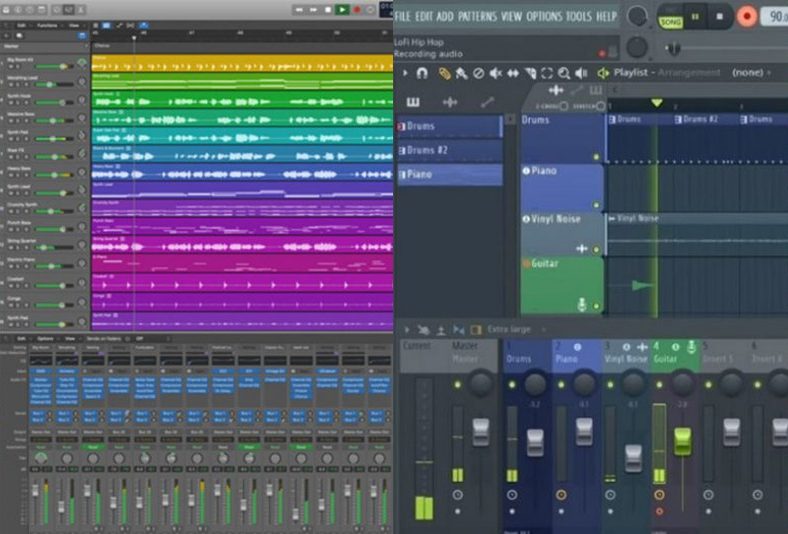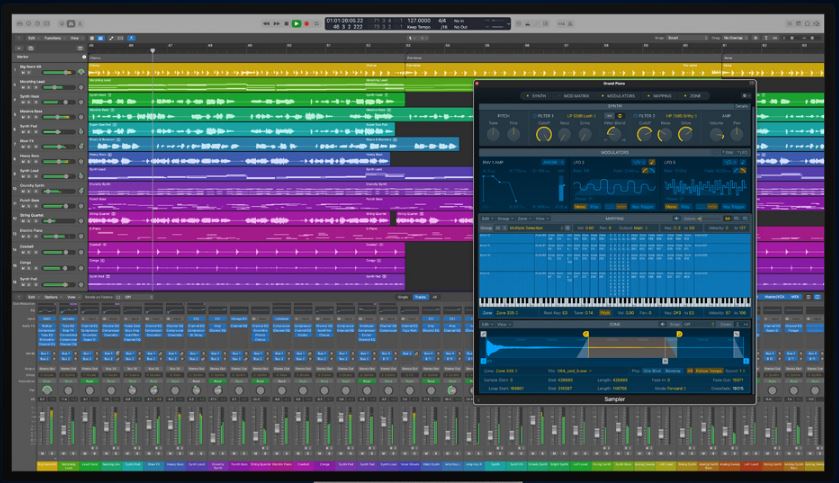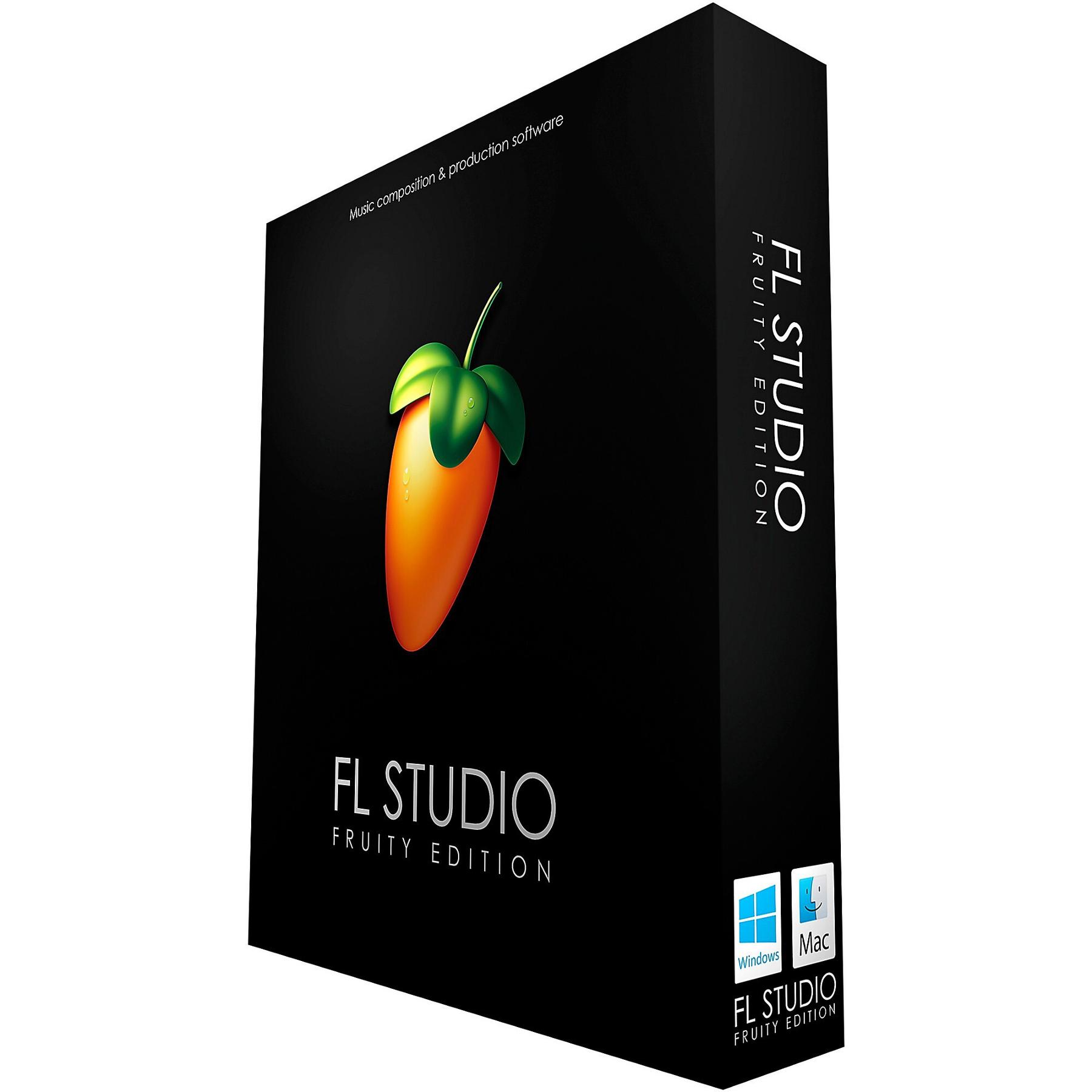Logic Pro vs FL Studio – Which is Better?

Logic Pro is a macOS-exclusive DAW with an excellent price-quality ratio and a world-class content library, whereas FL Studio is available for Windows and macOS and features a lot of fun, creative tools. Both programs are complete music-making powerhouses, but with disparate approaches to workflow.
Contents
Similarities between Logic Pro and FL Studio
- Both are complete, reputable, and popular DAWs.
- Both are perfect for beginners and professionals alike.
- Both feature a high-quality content library with audio samples, virtual instruments, and audio effects.
- Both offer flawless audio and MIDI-editing features.
- Both are compatible with macOS.
- Both integrate pop-up windows into their workflows.
Key differences between Logic Pro and FL Studio
- The complete suite of Logic Pro is more affordable than FL Studio’s top suite. You may have to pay almost twice as much to get access to the FL Studio All Plugins Edition.
- Logic Pro is only available for macOS, while FL Studio is available for both Windows and macOS.
- Logic Pro doesn’t have a mobile version, whereas FL Studio Mobile is available for Android, ChromeOS, and iOS.
- Logic Pro is a 64-bit exclusive, while FL Studio supports a 32-bit version.
- Logic Pro’s workflow is centered around its arrangement view, while FL Studio relies heavily on a useful pattern editor.
- Logic Pro is a more preset-based program, whereas FL Studio is more centered around sound design.
- Logic Pro allows you to load up to 3,000 tracks simultaneously, while FL Studio has a current limit of 500 tracks per session.
- Logic Pro doesn’t have as many upgrades as FL Studio.
- Logic Pro’s content library has more vocal-specific tools than FL Studio’s content library.
1. Apple's Logic Pro
Following the acquisition, Apple continued to work on the development of Logic and created a parallel, free software known as GarageBand. Today, both Logic and GarageBand make for two of the world's most popular DAWs, boasting similar layouts and features. Here's a breakdown of their main differences.
2. Image-Line's FL Studio
Later, Fruity Loops' name was changed to the more professional-sounding title of FL Studio, and the program went through a series of updates that turned it into a full-fledged DAW. FL Studio was a Windows-only music program up until 2018, the year a macOS version was introduced.
Pricing
Logic Pro is great in terms of pricing because it’s available in one version that already contains everything you need to make music. The DAW sells for approximately $200, which is a great price with no need for complicated limited-option suites and subscription programs.
You can get the entry-level FL Studio Fruity Edition for around $100 but you’ll have to get by with limited playlist features and, crucially, no audio recording. Realistically, you’ll have to spend at least a couple hundred dollars to get a highly functional version of FL Studio. To have access to the full-fledged FL Studio All Plugins Edition, you’ll have to pay more than twice the price of Logic Pro.
OS compatibility
Logic Pro is only available for macOS, which is rather disappointing, but not surprising since it’s owned by Apple. While many audio engineers choose top-performing Mac computers to make music, the fact is that Windows is still up to four times more popular than Mac. If you’re working on a Windows machine, you’ll need to make the switch to macOS to start using Logic Pro.
FL Studio is available for both Windows and macOS and takes OS compatibility further with its terrific music-production application – FL Studio Mobile.
Mobile compatibility
FL Studio Mobile is one of the best DAWs for mobile devices and comes with all the essential features that make FL Studio great. FL Studio Mobile is available for Android, Chrome OS, and iOS. Logic Pro, on the other hand, isn’t compatible with iOS devices unless you’re using a third-party app such as Logic Remote.
32-bit support
It’s also important to note that, unlike Logic Pro, FL Studio offers 32-bit support. While modern-day DAWs have been quick in dropping their outdated 32-bit versions, it’s still good to have the option to use one. Especially when there are still so many good VST instruments and audio effects that don’t work in 64-bit.
Workflow
When it comes to making music, workflow is (almost) everything. As a music producer, you want to get results as quickly as possible to avoid wasting time. Luckily, both Logic Pro and FL Studio are excellent workflow-wise, even though they work in slightly different ways.
Logic Pro is, above all, an arrangement-view DAW, meaning you’re supposed to work with one browser window on the left and one arrangement-view window on the right. You can open other windows, such as a step sequencer and piano roll, but you’ll only be using these sporadically. The arrangement-view window is the basis of all Logic Pro operations.
In FL Studio, chances are you’ll start creating beats using the pattern editor. The pattern editor allows you to come up with short loops that can later be dragged into the playlist editor (which is similar to Logic Pro’s arrangement view). While some producers may think of the pattern editor as an unnecessary tool, others view it as a quick and efficient way of drafting short musical ideas on the go.
Both DAWs rely heavily on pop-up windows (especially for selecting presets and loading audio effects) and feature a mixer. Useful shortcut keys are available for both programs.
Content library
Unlike DAWs such as Pro Tools, Logic Pro and FL Studio both feature a ready-to-use content library with lots of audio samples, virtual instruments, and audio effects. There are great tools in both libraries, but how do they stand up against one another?
Audio samples
When it comes to audio samples, Logic Pro is better than FL Studio. The audio-sample collection in Logic Pro is pretty impressive, featuring everything from cinematic textures and acoustic instruments to urban loops and classic drum machine sound packs.
Image-Line sells lots of sample packs via their official website, so they keep their built-in audio-sample library to the minimum. Some of the sounds in there are pretty outdated too, something you won’t feel while browsing through Logic Pro’s excellent sound library.
Virtual instruments
It’s harder to pick a winner in this one, as both Logic Pro and FL Studio have a different approach to virtual instruments. Logic Pro loves to keep it simple once again, listing an extensive collection of ready-to-use virtual instruments all in one place, regardless of the virtual instrument that’s powering each sound. FL Studio takes the more common approach, as it allows you to select from different virtual synthesizers and only then browse through a list of presets.
In other words, Logic Pro wants you to choose a virtual instrument and start playing, while FL Studio wants you to choose a synthesizer and probably work on an original patch before starting to have fun. If you’re into sound design, you’ll probably like the FL Studio approach better. Some of FL Studio’s featured virtual instruments are great too, especially the new Flex and the classic 3x OSC.
Audio effects
Once again, it’s hard to pick a clear winner, even though Logic Pro’s audio effects are a bit more professional-looking and consolidated. When it comes to the fundamentals, Logic Pro seems to have a slight advantage, especially due to their world-renowned compressor and selection of reverbs. That’s not to say FL Studio is bad with the basics, though: the FL reverb is great and the equalizer is as amazing.
When it comes to creative audio-effects tools, though, FL Studio seems to be ahead of Logic Pro. The clear standout is Gross Beat, which is already a classic tool among hip-hop beatmakers; it’s an excellent glitch effect that allows you to quickly chop beats and samples in creative and fun ways.
Sadly, not all audio effects in FL Studio are treated the same way, and you may get the feeling that their audio-effect bundle is highly incoherent. Less-popular audio effects such as the chorus boast a disappointingly poor GUI.
Verdict
Except for one or two key differences (mainly in technical aspects such as OS compatibility), Logic Pro and FL Studio are two DAWs that are very hard to set apart. They’re both classics of the world of music production, equally beloved by musicians and audio engineers alike. So, what’s the one that best suits your needs?
If you’re a longtime Windows user and you don’t want to change to a Mac machine, there’s no question that FL Studio is your DAW. Logic Pro is a macOS-exclusive program, and that’s not going to change anytime soon.
If you’re looking for a DAW that can be used on your mobile devices, FL Studio (and FL Studio Mobile in particular) is also the best option, as Logic Pro cannot be used on iOS devices without third-party software.
If you’re a skilled keyboard player looking for a DAW that will give you access to numerous high-quality virtual instruments on the go, then Logic Pro is your DAW. FL Studio has some great presets in there, but they’re mostly aimed at sound designers who love to tweak sounds and work on original synth patches.
If you want to have a complete DAW on a budget, you may want to go with Logic Pro. Uncomplicated and extremely affordable, Logic Pro can be yours, without annoying limitations and subscription programs, for a more-than-fair price of approximately two hundred dollars.
All things considered, Logic Pro and FL Studio will both fit your needs as a music producer, allowing for flawless audio recording, MIDI editing, and audio editing. Logic Pro is relatively simpler to use, but FL Studio comes loaded with lots of fun, creative tools that are very engaging for beginners (Gross Beat being the main standout).
If you don’t find either Logic Pro nor FL Studio to be very impressive, you can always check for alternatives in our list of the best DAWs.







